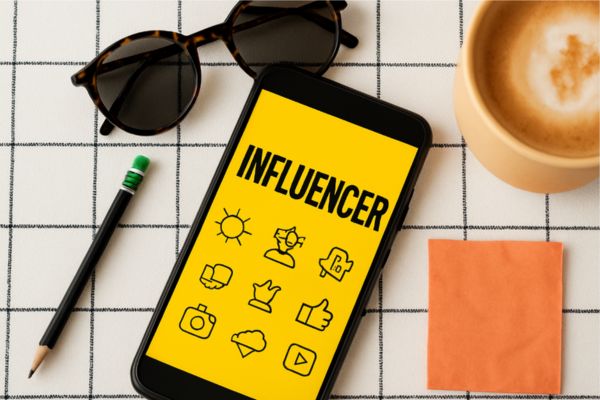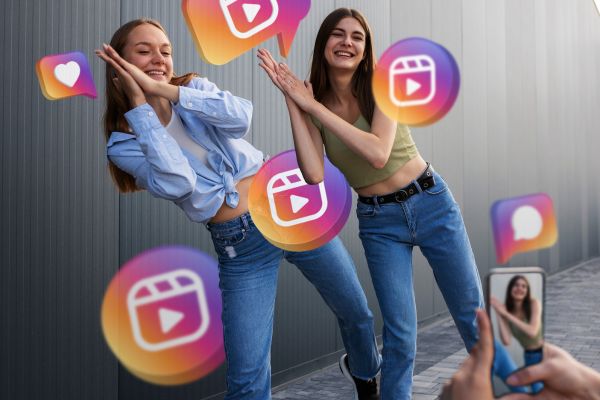Influencer marketing isn’t just a trend, it’s one of the most powerful ways brands connect with modern audiences. But finding the right creators, negotiating fair terms, and building authentic partnerships takes more than sending a few DMs.
If you’re wondering how to hire influencers who can truly move the needle for your business in 2025, you’re in the right place. In this guide, we’ll walk you through every step, from setting goals to launching campaigns and building lasting relationships that drive real results.

Step 1: Define Your Goals Before Hiring an Influencer
Before you start reaching out to influencers, it’s crucial to know exactly what you want to achieve. Hiring influencers without a clear objective often leads to mismatched partnerships and wasted budgets. Take the time to define your primary goals, whether it’s boosting brand awareness, generating qualified leads, driving direct sales, or building a loyal community around your brand.
Here’s a quick breakdown to help you match your goals with the right influencer strategy:
| Goal | Recommended Influencer Type | Example Campaign Idea |
| Brand Awareness | Macro or Mega Influencers | Sponsored post series, Product Unboxing Videos |
| Lead Generation | Micro Influencers | Lead magnet promotion (e.g., free eBook, webinar sign-up) |
| Direct Sales | Nano or Micro Influencers | Affiliate partnerships with promo codes |
| Community Building | Nano Influencers | Live Q&A Sessions, Collaborative Content Creation |
Once your goals are clear, translate them into SMART KPIs: specific, measurable, achievable, relevant, and time-bound targets.
- Specific: “Increase Instagram followers by 15% in Q3” (not “get more famous”)
- Measurable: Use tools like UTM links or influencer-specific promo codes
- Achievable: Nano-influencers won’t drive 1M views—adjust expectations
- Relevant: If you sell B2B software, TikTok dancers won’t help
- Time-Bound: “Drive 500 sales in 30 days”
Clear goals not only help you find the right creators but also make it much easier to measure the success of your campaigns later.
Step 2: Build a Target Influencer Profile
Not all influencers are created equal, and not every creator will be the right match for your brand. After setting clear goals, the next step is to build a target influencer profile that outlines exactly who you’re looking for.
Start by choosing the ideal platform based on your audience and objectives. TikTok is perfect for viral reach and Gen Z engagement, Instagram shines for visual storytelling and lifestyle brands, while YouTube works best for long-form product education and deeper audience trust.
Next, define the audience demographics you want your influencers to reach. Consider factors like age, gender, location, interests, and even language. The closer their followers mirror your ideal customer, the more effective your campaign will be.
Finally, think about content style and tone. Do you want polished, high-end visuals? Fun, relatable content? Educational how-tos? The influencer’s style should feel like a natural extension of your brand voice to maintain authenticity and maximize impact.
Step 3: Search and Shortlist Potential Influencers
With your ideal influencer profile in hand, it’s time to start the search. This step is all about casting a wide but strategic net, and then narrowing it down to a shortlist of high-potential creators who truly match your goals and audience.
Save time and avoid costly mistakes. Our Comprehensive Influencer Checklist for Effective Collaborations breaks everything down so you can run seamless, successful campaigns from start to finish.
Where to Find Them?
Finding the right influencers doesn’t have to be a guessing game. Here are some of the most effective methods:
- Creator marketplaces: Platforms like TikTok Creator Marketplace, Instagram’s Creator Marketplace, and YouTube BrandConnect let you search for influencers by niche, audience, and performance metrics.
- Social listening: Track trending hashtags, viral sounds, and popular challenges in your niche to spot rising creators organically.
- Competitor analysis: See which influencers are already working with brands similar to yours, they may be open to new partnerships.
- Influencer discovery platforms: Tools like Hypefy offer filters for audience demographics, engagement rates, and even past campaign performance to speed up the search.
Quick tip: Don’t limit yourself to the biggest names. Often, micro and nano influencers deliver higher engagement and more authentic connections for niche audiences.
What to Check Before Adding to Shortlist
Once you have a pool of candidates, it’s time to vet them carefully. Here’s what to look for before adding anyone to your shortlist:
- Audience health: Check for authentic followers and strong engagement rates (ideally above 2%). Watch out for sudden follower spikes or bot-like comment patterns.
- Content quality and consistency: Is their content visually appealing? Do they post consistently? Are they active on Stories, Reels, and Lives?
- Alignment with brand values: Review their past content and overall vibe. Does their tone, style, and messaging align with your brand image?
- Past brand collaborations: Look at previous partnerships. Have they worked with competitors? How well did they integrate brand promotions without seeming forced?

Step 4: Outreach to Influencers the Right Way
Once you’ve shortlisted potential influencers, it’s time to reach out to influencers correctly, and first impressions matter. Many brands lose great opportunities simply because their pitches feel cold, generic, or one-sided. To maximize your chances of a positive response, focus on building a genuine connection right from the start.
Personalize Your Pitch
Avoid sending copy-paste emails. Influencers can tell immediately when they’re just one of hundreds on a list. Start by mentioning something specific you admire about their content, a recent post, a campaign they worked on, or a cause they support. Show that you’ve done your homework and that your brand genuinely aligns with their style and audience.
Explain the Mutual Value (What’s In It for Them)
Remember, partnerships go both ways. It’s not just about what the influencer can do for you, it’s about what your brand offers them. Highlight benefits like exclusive products, generous compensation, creative freedom, or opportunities to reach new audiences. Influencers are more likely to collaborate when they feel respected and valued, not just hired.
Timing and Follow-Ups
Timing can make or break your outreach. Try to reach out during off-peak periods (avoid major holidays unless it’s campaign-related) when creators are less swamped. If you don’t hear back right away, a polite follow-up after 5–7 business days is perfectly acceptable. Keep it brief, respectful, and understanding. Persistence works better when paired with patience.
Step 5: Negotiate Terms and Set Expectations
After an influencer expresses interest, it’s time to move into negotiations. Setting clear terms upfront is essential to avoid misunderstandings, protect both parties, and ensure the collaboration runs smoothly. Think of this step as building the foundation for a successful campaign, with everything important spelled out in black and white.
Deliverables: Posts, Stories, Videos, Live Streams
Be crystal clear about what content the influencer is expected to produce. Is it one Instagram post and three Stories? A TikTok video with a call-to-action? A YouTube integration with a product mention? List each deliverable, the format, and any specific messaging or brand tags that must be included.
Payment: Fixed Fee vs Performance-Based Compensation
Discuss the payment model early. Some brands prefer a fixed fee (paying a set amount for agreed deliverables), while others offer performance-based compensation (bonuses for hitting targets like sales or engagement). A blended model, a base fee plus performance incentives, often works best, motivating influencers without undervaluing their work.
Paying influencers doesn’t have to be a headache. Use the Hypefy Influencer Payment Platform to handle global payouts, currency conversions, and compliance, all in one place.
Content Usage Rights: Who Owns the Content After Posting?
Ownership and usage rights can get tricky if not discussed upfront. Make sure to clarify:
- Can you repurpose their content for ads or future promotions?
- Is there a time limit on how long you can use it?
- Will the creator retain ownership but grant you usage rights? Including clear terms protects both your brand and the creator.
Timeline and Milestones
Set realistic timelines for content creation, review, and publishing. Break down the collaboration into milestones if needed (e.g., draft review, final submission, live date). Clear timelines help everyone stay on track, especially when campaigns are tied to product launches, holidays, or promotions.
Step 6: Draft and Sign a Clear Influencer Agreement
A handshake deal might seem easier, but when real money and brand reputation are involved, a proper agreement is essential. A clear, written influencer contract protects both sides, outlines expectations, and prevents potential misunderstandings that could derail your campaign.
Scope of Work
Define exactly what the influencer is being hired to do. List all deliverables (posts, Stories, videos, Lives) and specify the channels they’ll be published on. If there are specific creative directions, like including a product demo or highlighting a promotion, outline them here without limiting the creator’s authentic voice.
Payment Terms
Detail how much you’re paying, what milestones trigger payments (e.g., after content approval or post-publication), and when payments are due. Include any agreed-upon bonuses for overperformance, as well as what happens if either side cancels the agreement midway.
Deadlines and Deliverables
Include key dates for:
- Draft submission
- Revisions (if applicable)
- Final approval
- Publishing/posting schedule
Clear timelines keep campaigns running smoothly, especially if you’re syncing influencer content with larger marketing pushes like product launches or seasonal promotions.
Disclosure and Compliance (FTC, ASA Rules)
Make sure your contract requires compliance with advertising regulations. Influencers must clearly disclose sponsored content in accordance with the FTC guidelines (U.S.) or ASA rules (U.K.). This typically means using hashtags like #ad or #sponsored, or clear verbal disclosures in videos. Non-compliance could result in fines or damage your brand’s credibility, so it’s crucial to include this in writing.
Pro Tip: Always allow for minor creative freedom within the contract. Influencers know best how to engage their audiences authentically, strict scripts can backfire.

Step 7: Share a Detailed Campaign Brief
Even the most talented influencers need clear direction to deliver the results you expect. A well-crafted campaign brief bridges the gap between your brand vision and the creator’s unique style, ensuring the final content feels authentic, on-brand, and goal-driven.
Brand Voice Guidelines
Explain how your brand “sounds” — formal or friendly, witty or inspirational, bold or understated. Share examples of past posts, slogans, or even words you often use (and avoid). Helping influencers capture your voice naturally improves brand consistency without making their content feel forced.
Creative Dos and Don’ts
Give clear but flexible creative guidance.
✔️ Do highlight the product in everyday life settings.
❌ Don’t create direct “hard sell” ads.
✔️ Do use natural language and storytelling.
❌ Don’t alter logos, slogans, or brand colors.
This kind of simple list respects the creator’s freedom while keeping essential brand elements protected.
Key Product Messaging
Focus on the core messages you want the audience to walk away with, not scripted lines. For example:
- Highlight the product’s eco-friendly materials.
- Emphasize the “30-day free trial” offer.
- Mention the limited-time discount code.
Providing these points helps influencers naturally weave important brand information into their own storytelling style.
Submission and Approval Process
Clearly outline how and when content needs to be submitted for review.
- What platform to send drafts (email, platform tool)?
- How much lead time do you need for approvals?
- How many rounds of revisions are allowed?
A transparent review process reduces stress for both sides and ensures everything stays on schedule.
Step 8: Manage the Campaign and Measure Performance
Once your influencer content goes live, the work isn’t over, it’s just shifting gears. Actively managing the campaign and measuring performance ensures you stay on track, spot opportunities for optimization, and gather valuable insights to improve future collaborations.
Measuring success is just as important as launching the campaign. Learn how to evaluate and optimize performance in Influencer Marketing ROI: How to Measure & Maximize Returns.
Tools for Tracking Performance (UTMs, Promo Codes, Dashboards):
Make sure you set up tracking before the first post is published.
- UTM Parameters: Add UTM codes to links influencers share to track traffic sources in Google Analytics.
- Promo Codes: Assign unique discount codes to each influencer to easily track direct conversions and sales.
- Performance Dashboards: Some influencer marketing platforms offer real-time dashboards to monitor reach, engagement, and conversions across all campaigns in one place.
Quick Tip: Share easy-to-use tracking links and codes with your influencers in advance to avoid missing data.
Metrics to Monitor – Reach, Engagement, Conversions, ROI:
Focus on the metrics that align with the goals you set at the beginning:
- Reach: How many people saw the content?
- Engagement: Likes, comments, shares, saves — showing audience interaction.
- Conversions: Sales, signups, downloads, measurable actions taken.
- ROI: Return on investment, revenue generated compared to total campaign costs.
Remember, high engagement with a smaller, highly relevant audience often drives better results than broad reach with low interaction.
Provide Feedback During the Campaign:
Don’t wait until the end to communicate. Offer real-time feedback to influencers based on early performance insights:
- Congratulate them on high-performing posts.
- Suggest quick pivots if something isn’t resonating (e.g., different call-to-action wording, switching content format).
- Keep communication positive, constructive, and supportive.
An open feedback loop helps optimize results and strengthens the relationship for future partnerships.
Step 9: Build Long-Term Influencer Relationships
The best influencer partnerships don’t end when the campaign does. If a collaboration went well, it’s worth nurturing the relationship. Building long-term connections with creators leads to deeper brand loyalty, more authentic endorsements, and better results over time.
Post-Campaign Debrief and Gratitude
After the campaign wraps up, schedule a quick debrief, even a simple email or call works.
- Share performance highlights (what worked well)
- Offer constructive feedback (if any improvements are needed)
- Most importantly, thank them for their effort and creativity
A genuine “thank you” goes a long way toward making influencers feel like true brand partners, not just vendors.
Discuss Future Collaborations
If the influencer delivered strong results and aligned well with your brand, explore opportunities for future work:
- Multi-campaign partnerships
- Ambassador programs
- Exclusive product launches
- Content collaborations beyond social media (e.g., blog features, event appearances)
Long-term partnerships reduce onboarding time, increase authenticity, and often come with better rates compared to one-off deals.
How Long-Term Partnerships Amplify Trust
Audiences are smart, they can tell when an influencer genuinely loves a brand versus when it’s just a one-off ad.
When a creator consistently features your product over time, their audience builds trust not only in them but also in you. This deeper trust translates into higher engagement, better conversion rates, and stronger brand equity.
Tip: Offer perks for repeat collaborators, early access to products, bonus incentives, or co-creation opportunities, to keep top influencers invested in your brand’s success.

Key Takeaways for Hiring Influencers Successfully
Hiring influencers isn’t just about finding popular creators, it’s about building meaningful, strategic partnerships that drive real business results.
Ready to put these steps into action? Whether you’re building your first influencer campaign or scaling up existing partnerships, having the right tools and strategy makes all the difference. Explore Hypefy to discover, vet, and collaborate with top creators, and take your influencer marketing to the next level.



